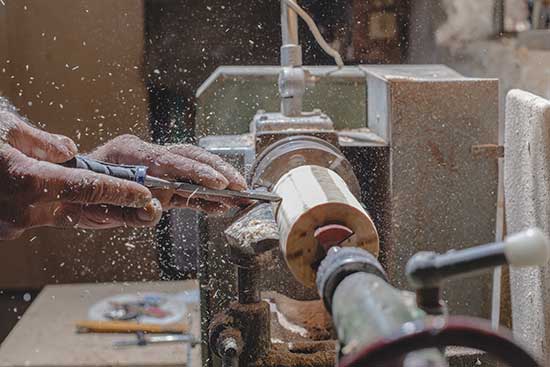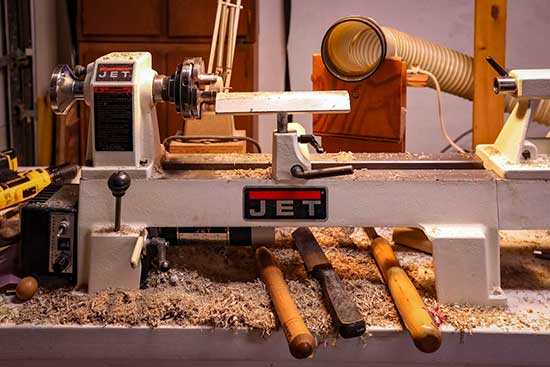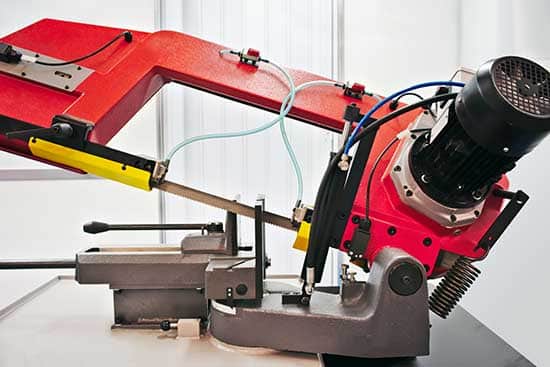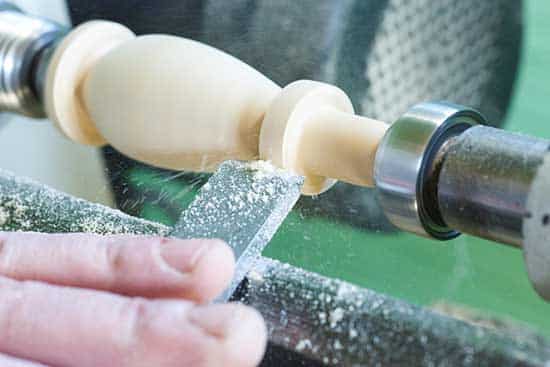Woodturning: How to Get Started and Improve Your Skills
 Woodturning, an age-old craft, began back in ancient Egypt and has since become an integral part of woodworking around the globe. It involves shaping wood on a lathe, a machine that spins the workpiece on its axis while the woodworker uses various cutting tools to create intricate designs and beautiful forms.
Woodturning, an age-old craft, began back in ancient Egypt and has since become an integral part of woodworking around the globe. It involves shaping wood on a lathe, a machine that spins the workpiece on its axis while the woodworker uses various cutting tools to create intricate designs and beautiful forms.
Wanting to learn how to do it yourself?
In this comprehensive guide, we’ll explore the world of woodturning with the help of advice from expert Simon Begg of Simon Begg’s Woodturning. Here’s what you can expect to learn:
- Essential woodturning tools and equipment
- Woodturning techniques
- Moisture and woodturning
- Project ideas
- Common issues
- Tips for improving your skills
- Advanced techniques
Let’s jump right in!
Essential Woodturning Tools and Equipment
 The first step on your woodturning journey is making sure you have the necessary tools and equipment for success.
The first step on your woodturning journey is making sure you have the necessary tools and equipment for success.
In summary, you’ll need:
-
- A wood lathe
- Chucks
- Various turning tools
- Bandsaw
- Sharpening tools
- Safety gear
Wood lathe
The foundation of woodturning, a wood lathe spins the workpiece while you shape it using various cutting tools. Lathes come in different sizes and types, each designed for specific tasks and workspaces.
For beginners, we recommend starting with a mini or midi lathe due to its affordability, compact size, and versatility. These smaller lathes typically have a swing (the maximum diameter of a workpiece) between 10 and 12 inches and a distance between centers (the maximum length of a workpiece) of 16 to 20 inches, making them suitable for small to medium-sized projects.
But Simon points out, “Most people will outgrow them quickly.” That’s why he recommends finding a full-size lathe second-hand. They end up being about the same price as a new mini lathe.
Chucks
Most people who explore woodturning use chucks—unless they’re only doing spindle work. Chucks allow you to securely hold a piece of wood on a lathe during the turning process. This way, you can shape and work on the wood without it moving or coming loose.
Turning tools
A well-rounded set of turning tools is essential for creating an array of shapes and forms. Some key ones are:
- Gouges: These tools have a curved cutting edge and are primarily used for roughing out and shaping workpieces. Gouges come in different sizes and shapes. Specifically, spindle roughing gouges can help reduce the wood to size, while spindle gouges can shape beads and coves, and detail gouges work for finer details.Bowl gouges have quite a different grind. They are more rigid and suitable for more reach, making them perfect for bowls.
- Scrapers: Scrapers have a flat cutting edge and are used to refine and smooth surfaces. You can use them to remove tool marks left by gouges or skew chisels.
- Skew chisels: These have a long, angled cutting edge and are used to produce clean cuts and fine details. Skew chisels can be challenging to master but are highly versatile, enabling you to create V-cuts, beads, and smooth planing cuts.
- Parting tools: These tools have a narrow cutting edge and are used to size up diameters for spindle work. They can also be used to cut and separate pieces, such as turning a tenon or defining the diameter of a spindle.
- Specialty tools: These include hollowing tools for hollow-form turning, texturing tools for adding decorative elements, or captive ring tools for creating rings on a spindle. It all depends on the specific project you’re working on.
Bandsaw
 While the primary tool for shaping wood is the lathe, a bandsaw is very important for preparing wood. It can be used for:
While the primary tool for shaping wood is the lathe, a bandsaw is very important for preparing wood. It can be used for:
- Roughing out a blank from a larger piece of wood
- Cutting larger timber into thinner boards
- Cutting segments for segmented turning
- Creating veneers
Sharpening tools
Sharp tools are critical for quality woodturning. Otherwise, you may end up with rough cuts, tear-outs, or even dangerous catches. And a rougher finish means more sanding for you!
To keep your tools sharp, invest in a good bench grinder (preferably with a slow speed setting) and sharpening jigs or accessories. Sharpening jigs help maintain the correct bevel angle and cutting edge profile, ensuring consistent and precise cuts.
Safety gear
To minimize risks while working with a wood lathe, equip yourself with the following:
- Eye protection: Simon strongly recommends wearing a face shield over safety glasses for protecting your face and eyes from flying wood chips and debris.
- Dust masks: Use a dust mask or respirator to prevent the inhalation of harmful wood dust, especially when working with certain species of wood known to cause respiratory issues.
- Hearing protection: Woodturning can be noisy, particularly when you’re using power tools or working with harder wood.
- Appropriate clothing: Wear close-fitting clothing to avoid getting caught in the spinning lathe. And skip the gloves since they can become entangled in the lathe and cause accidents.
Woodturning Techniques
Woodturning involves a number of core techniques that you should master before moving on to more advanced ones. We’ll walk through the basic woodturning process here:
Prepare the wood blank
Selecting the right wood and preparing the blank are the foundations of any successful woodturning project.
Depending on your desired outcome, you could choose either hardwoods like maple, walnut, and cherry or softwoods like pine and cedar. Hardwoods offer durability and a finer finish. Softwoods are easier to work with but may be less resilient. Verify the moisture content of the wood is appropriate (we’ll discuss this later in the article in greater depth).
When cutting up the log, make sure to remove the pith (the center of the tree) because a lot of cracking and instability can come from there during the drying process.
Then, cut the wood blank to the appropriate size and shape for your project, ensuring that it is free of defects like cracks or knots. Mount the blank on the lathe, either between centers (for spindle turning) or using a faceplate or chuck (for faceplate turning).
Make sure the blank is mounted securely and properly aligned to ensure stability during turning.
Basic tool handling
Learn the correct methods for using different tools so you can achieve precise and smooth cuts. Here are two basic ones:
- Bevel rubbing technique: This technique is for gouges and skew chisels. Position the tool’s bevel—the angle of the cutting edge—against the wood and gradually raise the handle until the cutting edge engages the material. This will give you better control and smoother cuts while minimizing the risk of catches.
- Scraping motion: For scrapers, employ a scraping motion by holding the tool flat on the tool rest and angling it slightly downward to engage the cutting edge. Apply gentle pressure to remove material and refine the surface.
Creating shapes and forms
To build up your woodturning skills, practice producing the following basic shapes. They’ll pave the way for you to make more intricate and complex designs.
Cylinders
Turning a simple cylinder is often the first step in many woodturning projects. To create a cylinder:
- Begin with a roughing gouge, positioning the tool’s bevel against the spinning wood, and gradually raising the handle until the cutting edge engages the material.
- Move the roughing gouge along the length of the workpiece, removing material in a controlled manner to create a uniform cylindrical shape.
- Once the desired diameter is achieved, use a skew chisel or scraper to refine and smooth the surface. When using a skew chisel, employ the bevel rubbing technique and make light, controlled cuts. With a scraper, maintain a slightly downward angle and apply gentle pressure to remove any tool marks or irregularities.
Tapers
Tapers add dimension and shape to your woodturning projects. Here’s how to make them:
- Choose the appropriate tool, such as a spindle gouge or skew chisel, and position the bevel against the spinning workpiece.
- Determine the direction of the taper (towards or away from the headstock) and gradually remove material along the length of the piece while maintaining a consistent angle relative to the workpiece’s axis. You can use a parting tool and calipers to set the diameters for consistency.
- Continuously check the taper’s profile to ensure a smooth transition and make adjustments as necessary.
Beads
- With a pencil, mark the bead’s boundaries on the workpiece, including the edges and the middle. Then, position the tool’s bevel against the wood, starting at one end of the marked area.
- Use a skew chisel on edge to set the boundaries and the depth of the bead.
- Make a controlled, rolling cut, gradually lifting the handle and simultaneously rotating the tool to create a rounded shape. Repeat this process on the opposite side of the bead to form a symmetrical, convex profile.
- Refine the bead’s shape by making light, precise cuts and sanding as necessary.
Coves
Coves incorporate concave shapes into your designs.
- Choose a spindle gouge, which has a curved cutting edge ideal for creating coves.
- Mark the cove’s boundaries and depth on the workpiece, then position the tool’s bevel against the wood, starting at the highest point of the cove.
- Use a scooping motion, gradually lowering the handle and rotating the tool to remove material and create a concave shape. Work from the highest point of the cove towards the marked boundaries, maintaining control of the tool and ensuring a smooth, uniform curve.
- Make any necessary refinements by making light cuts and sanding the cove to achieve a smooth, even surface.
Sanding and finishing
A well-sanded and finished piece is the hallmark of quality woodturning.
Start with a coarse grit sandpaper (80–120 grit) and progressively work your way through finer grits (up to 400–600 grit). Sand with the lathe running at a low speed, and always sand along the grain when the lathe is off to remove any cross-grain scratches.
To enhance and protect your work, you have quite a few finish options:
- Oil (for a natural look)
- Wax (for a low-luster finish)
- Lacquer (for a durable, high-gloss finish)
- Varnish (for a resilient, glossy finish)
Apply the finish according to the manufacturer’s instructions and allow it to cure properly for the best results.
And there you go—that’s the process of woodturning. Let’s find out how moisture plays into this process.
Moisture and Woodturning
Paying attention to wood moisture content (MC) is an important aspect of any type of woodworking project—especially since moisture contributes to about 80% of problems in wood projects!
Wood naturally holds moisture in its cells. It starts out full of water in the center of the cells, but that water dries off first. Once all of that water has dried out, the wood reaches its fiber saturation point, which is about 28–30% MC.
From there, moisture begins to leave the cell walls because wood naturally wants to reach the moisture content of its environment (called the equilibrium moisture content or EMC). This can cause the wood to shrink and potentially warp.
Before working with wood, the goal is usually to get the wood to its EMC so that it won’t shrink or warp when it’s finished.
But issues will arise in woodturning—or other woodworking projects—if the wood hasn’t reached that number.
Problems include:
- Shrinkage and warping: As wood loses moisture, it shrinks and can cause warping, cupping, or twisting. For woodturners, this can result in an uneven final product. A bowl, for instance, may end up becoming oval-shaped as it dries.
- Cracking and checking: Shrinking can cause wood to experience internal stresses. It may crack or check as a result. These can occur at any stage of the woodturning process and can range from surface cracks to deep splits that compromise the structural integrity of the piece.
- Differential drying rates: The varying densities and grain orientations in a piece of wood can lead to different drying rates. The result can be unwanted shapes and forms in the final product.
- Changes in workability: The MC of wood can also affect its workability during turning. Generally, wet wood is easier to turn and can result in smoother surfaces. On the other hand, drier wood can be harder to work with, potentially leading to tear-outs and rough surfaces.
So how do you avoid these challenges? Let’s look at some strategies:
Using green wood
For most woodworking projects, we wouldn’t recommend using green wood—but woodturning is a little different.
Green, or unseasoned, wood with its high moisture content is often easier to work with than dry wood.
But keep in mind:
Wood with a high moisture content percentage will shrink and warp as it dries.
This is very important to understand, as round or cylindrical objects are very noticeable when they shrink unevenly (which they will) or twist.
When it comes to turning green wood, there are two key techniques that can help minimize issue:
- Rough turning: Rough turning involves shaping the wood while it’s still wet. This removes the excess bulk of the wood, creating a rough form or a basic shape (about 1-inch thick). By doing this, the woodturner can accelerate the drying process and reduce the risk of severe cracking or warping as the wood dries. Once the wood has reached the proper moisture content, the woodturner will complete the turning.
- Thin wall turning: Thin wall turning is a technique for creating delicate and thin-walled objects from green wood. While green wood is generally easier to turn, thin walls can be challenging due to the potential for warping or cracking during drying.To overcome this challenge, woodturners may opt for smaller-sized projects where the natural drying process can occur more evenly, reducing the risk of significant distortion. Or, some woodturners use specialized drying methods, such as using a microwave or a drying kiln, to speed up the drying process and minimize the moisture gradient within the wood, which helps to maintain the shape of thin-walled pieces.
It’s worth noting that even with these techniques, some level of distortion or warping may still occur during the drying process, especially with highly moisture-sensitive woods.
Controlled drying
Decrease the chances of moisture damage by controlled drying—a process that allows the wood to dry slowly and evenly and with less risk of cracking and warping.
Testing moisture content
 Even though you may start off turning somewhat green wood, you’ll still want the finished product to be at the right moisture content (MC) for your region.
Even though you may start off turning somewhat green wood, you’ll still want the finished product to be at the right moisture content (MC) for your region.
Figure out the EMC of its final location using an EMC chart. Then, measure the MC of the wood with a moisture meter to make sure your wood matches.
These steps will take away any worries about moisture issues with your completed masterpiece.
Woodturning Project Ideas for Beginners
As you get more comfortable with the basic woodturning techniques, you can begin exploring some beginner-friendly projects. These projects are a great way to apply your newfound skills and gain confidence and experience.
We have three initial ideas for you:
1. Pens and pencils
- Crafting custom pens and pencils is an excellent way to practice your woodturning skills and create unique, personalized gifts.
- Purchase pen kits that include all necessary components, such as the pen mechanism, ink cartridge, and metal hardware. These kits come in various styles and finishes, allowing you to create a wide range of designs.
- Select a suitable wood blank and pre-drill it to accommodate the pen kit components. Mount it on the lathe using a pen mandrel or a collet chuck.
- Turn the blank into a smooth cylinder, then shape the pen or pencil body according to your desired design.
- Sand and finish the piece to achieve a professional appearance.
- Assemble the pen or pencil components following the kit’s instructions.
2. Bottle stoppers
- Making bottle stoppers will allow you to experiment with different materials and designs.
- Choose a suitable material, such as wood or acrylic, based on your desired look and functionality. Wood offers a natural, warm appearance, while acrylic provides vibrant colors and patterns.
- Mount the material on the lathe using a bottle stopper mandrel, chuck, or faceplate.
- Turn the blank into the desired shape, incorporating elements like beads, coves, or tapers to add visual interest.
- Sand the stopper and apply a food-safe finish that protects the material and enhances its appearance.
- Attach suitable bottle stopper hardware, such as a cork or silicone stopper, to complete the project.
3. Bowls and platters
 Explore various forms and sizes of bowls and platters while developing your skills in faceplate turning.
Explore various forms and sizes of bowls and platters while developing your skills in faceplate turning.
- Choose an appropriate wood blank, considering factors like stability, grain pattern, and moisture content. A dry, stable blank is ideal for beginners, as it minimizes the risk of warping or cracking.
- Mount the blank on the lathe using a faceplate or a scroll chuck. Ensure the blank is securely attached and properly balanced.
- Begin by turning the exterior of the bowl or platter, shaping the base and creating a smooth, even surface. Make sure you’ve accounted for a way to remount it so you can hold it from the inside. You can do this with a tenon or recess.
- Hollow the interior using a bowl gouge or scraper, taking care to maintain an even wall thickness throughout.
- Sand the bowl or platter and apply a food-safe finish.
Common Woodturning Issues
As you progress in your woodturning journey, you may encounter challenges such as tool catches, uneven surfaces, or cracks in the wood. In this section, we’ll look at how to solve these issues and get better results.
Tool catches
Tool catches occur when the cutting edge of the tool digs too deep into the wood, causing the workpiece to stop abruptly or the tool to be jerked out of your hands.
Solution: Maintain the proper bevel contact and tool angle. Also, don’t press too hard into the wood—instead let the lathe do the work. Develop better tool control through practice and focus on making light, controlled cuts. Always ensure your tools are sharp, as dull tools can lead to catches.
Uneven surfaces
An uneven surface may result from inconsistent tool pressure or poor technique.
Solution: Practice maintaining consistent pressure and tool angle when turning. Use a shear scraping technique with a sharp scraper or skew chisel to refine the surface.
Sand the workpiece progressively, starting with a coarse grit and working your way to a finer grit, ensuring that all tool marks and irregularities are removed.
Warping or Cracks in the wood
Wood may develop cracks due to drying, internal stresses, or turning too thin.
Solution: If you’re turning the wood before it’s dried down to EMC, make sure you leave enough extra in that rough turn to account for dimensional change. Seal the end grain of the rough-turned wood with wax or a sealer to slow down the drying process and reduce the risk of cracking. Maintain even wall thickness when turning and avoid turning too thin, especially in areas prone to cracking.
Rough turning usually involves turning the piece to 1-inch thick and setting it aside to dry. Once it’s dry—moisture content is within a couple percent of the EMC—remount it on the lathe and turn it again to remove warping and get the desired shape.
A Few Tips for Improving Your Woodturning Skills
How do you get better at woodturning? Here are some ways you can be intentional about it:
- Master tool control: Practice different tool handling techniques to develop better control, leading to smoother cuts and more precise results. Focus on maintaining the correct bevel contact and tool angle, and avoid applying excessive force.
- Learn from experts: Watch woodturning demonstrations or attend workshops to learn from experienced woodturners. Observing and learning from others can provide valuable insights and help you avoid common pitfalls.
- Join local woodturning clubs and online communities: Connect with fellow woodturners to share tips, seek advice, and stay inspired. These communities can offer support, feedback, and camaraderie, fostering your growth as a woodturner.
- Regular practice: You already know what practice makes, so we won’t repeat it! But really, dedicate regular time to honing your skills and developing your unique style. Set achievable goals and track your progress, allowing yourself to learn from each project and grow as a woodturner.
Remember that patience, persistence, and a commitment to learning will be instrumental in your growth as a woodturner.
Soon, you’ll be ready to take those skills to the next level…
Expanding Your Woodturning Horizons
As you become more proficient in woodturning, it’s time to delve into advanced techniques, materials, and creative expression. In this section, we will discuss how to challenge yourself further and enhance your woodturning expertise.
Advanced techniques
Push your woodturning boundaries by mastering these advanced techniques: segmented turning, multi-axis turning, and hollow-form turning.
Segmented turning
- Develop a design for your segmented project, considering the desired shape, size, and pattern. Plan the number and types of wood segments you’ll need, and create a cutting list and assembly sequence. (Note: Segmented turning works with dry wood only).
- Using a table saw or a miter saw with a sled, cut the wood segments to the required dimensions and angles, ensuring clean and accurate cuts for tight-fitting joints.
- Begin gluing the segments together in stages, starting with individual rings or sections. Use clamps or specialized clamping jigs to maintain even pressure and alignment during the glue-up process. Allow the glue to dry fully before proceeding to the next stage.
- After the glue has dried, flatten and true the faces of the glued-up rings or sections using a disk sander, drum sander, or hand-sanding techniques. This step ensures a smooth and even surface for subsequent glue-ups.
- Stack and glue the rings or sections together according to your design and assembly plan, ensuring proper alignment and orientation. Use clamps or a specialized press to apply even pressure during the glue-up process, and allow the glue to dry fully.
- Mount the assembled segmented blank on the lathe using a faceplate, chuck, or another appropriate mounting method. Turn the piece to the desired shape and profile using a combination of gouges and scrapers, taking care to maintain control and avoid tear-out.
Multi-axis turning
- Develop a design for your multi-axis project, considering the desired shape, size, and the number of axes you’ll use. Mark the different axis points on your workpiece, clearly labeling them for easy reference.
- Mount the workpiece on the lathe using the first set of axis points. Turn the desired shape or profile along this axis, using gouges and scrapers to achieve clean and smooth cuts. Remove the workpiece from the lathe once the turning for this axis is complete.
- Re-mount the workpiece on the lathe using the second set of axis points. Turn the desired shape or profile along this axis, taking care to blend the new cuts with the existing shapes from the first axis turning.
- If your design involves more than two axes, continue the process of re-mounting the workpiece and turning along each additional axis. Ensure a smooth transition between the shapes and profiles created by each axis.
- Once all the axis turnings are complete, sand the multi-axis piece to achieve a smooth and even surface.
- Apply the desired finish, such as oil, wax, lacquer, or varnish, to enhance and protect your work.
Hollow-form turning
This technique focuses on creating hollow vessels with small openings, often requiring specialized hollowing tools.
- Begin by mounting your workpiece between centers to get the shape. Include a tenon on the bottom or a flat section for a faceplate. Leave plenty of material near the bottom to limit vibration. Then, mount on the lathe using a faceplate or chuck.
- Turn the exterior shape of your vessel using a combination of gouges and scrapers, ensuring smooth curves and transitions. Create a mounting tenon on the base and a small opening for hollowing at the top. Make sure the opening is appropriately sized to accommodate your hollowing tools.
- Using specialized hollowing tools, such as hook tools, carbide-tipped cutters, or even articulated-arm systems, begin removing material from the interior of the vessel. Work from the center outwards, using light cuts to avoid catches or tear-out. Frequently check the wall thickness using calipers or thickness gauges, and monitor your progress with inspection lights or borescopes.
- Once the hollowing is complete, sand both the interior and exterior surfaces. For the exterior, work through progressively finer grits of sandpaper, using a combination of hand-sanding and power-sanding techniques. For the interior, use custom-made sanding tools or abrasive meshes and pads mounted on flexible shafts to reach all areas.
- Remove the mounting tenon and finish the base of the vessel. Apply the desired finish to the entire piece.
Incorporating other materials
Introducing materials other than wood to your projects can add a touch of modernity, contrast, and visual interest. Some options are:
- Resin: Combine wood and resin for striking hybrid blanks, showcasing the interplay between natural wood grain and vibrant, translucent resin. Resin can also be used to fill voids or cracks, adding a unique decorative element.
- Epoxy: Similar to resin, epoxy can be used to create custom inlays, secure decorative elements, or add color and contrast to your work. Experiment with various pigments, metallic powders, or even natural materials like crushed stone to enhance your designs.
- Metal inlays: Metal inlays can add a luxurious and refined touch to your wood-turned pieces. Metals like brass, copper, or aluminum can be used to create decorative accents, inlays, or embellishments, adding a contrasting element to your work.
Exploring artistic and creative expression
 If you’re the artsy type, this section is for you! There are so many ways to make your woodturning projects unique.
If you’re the artsy type, this section is for you! There are so many ways to make your woodturning projects unique.
Start by sketching and planning your designs before turning. This will help you visualize your concepts, identify potential challenges, and refine your artistic vision.
You may want to push your creative boundaries by exploring unconventional shapes, forms, and textures in your woodturning projects. As you grow as an artist, you’ll find inspiration from various sources, such as nature, architecture, or other art forms.
Something else you can do is enhance your wood-turned pieces with surface decorations like carving, pyrography, or painting. These techniques can add depth, personality, and a unique flair to your creations.
Woodturning offers you endless possibilities for expressing your ideas. Let the creativity begin!
Give Woodturning a Shot!
So, what do you think? Are you ready to try woodturning for yourself, or kick it up a notch?
Yes, it’ll have a learning curve. But as you grow in skill and confidence, you’ll find yourself taking on bigger challenges and producing better and better results.
If you give it a try, leave us a comment below and share your progress!
Find out why it’s important to know the correct moisture content for your woodworking projects.

Wagner Meters is a family-owned American business that aims to provide solutions in moisture measurement technology that will enhance the quality and value of each customer’s project. With an almost 60-year legacy of innovation, Wagner continues to be a resource for both individual craftsmen and high-performance commercial endeavors.
Last updated on March 20th, 2025




